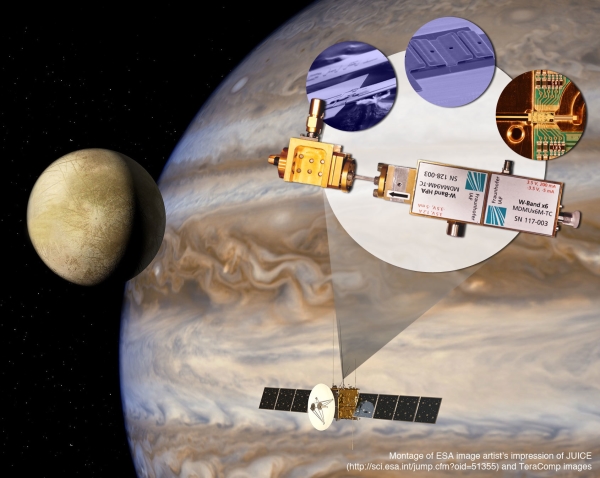Oct 07, 2013
A high performance terahertz receiver aiming for space missions such as ESA’s “Jupiter icy moons explorer” has been developed in a joint European effort, led by Chalmers University of Technology.
Remote analysis of gases and vapours by heterodyne spectroscopy is a powerful tool in environmental monitoring, astronomy, and planetary research. Particularly for space applications, compact, light-weight and robust heterodyne spectrometers are necessary.
In a joint European effort, researchers have developed a heterodyne receiver which satisfies the requirements set by space missions. This is achieved by minimising the number of components in the local oscillator (LO) of the receiver, and by a high degree of integration of all of its subcomponents.
“The unique sensor is compact, light-weight, robust and operates at room temperature, a necessity for satellite missions requiring many years of operation”, says project leader Jan Stake, professor at Chalmers University of Technology.
The receiver is optimised for the frequency band from 520 to 590 GHz. In this range, water vapour and a number of other important atmospheric trace gases, have significant spectral lines.
The researchers have achieved record performance in terms of sensitivity (noise).The key to this result is the high performance semiconductor devices used, and within the project a complete in-house membrane integrated Schottky diode process, suitable for terahertz applications, has been developed at Chalmers.
“The results demonstrate that the receiver is very well suited for remote sensing of atmospheres and astronomical objects”, says Jan Stake. “Due to its small mass and input power, the receiver is particularly suited for planetary missions such as ESA’s JUICE (Jupiter Icy Moons Explorer) mission.”
The receiver is a direct result of a project called TeraComp, a collaboration between European universities, institutes and industry, funded by the European Commission.
Within the project, Omnisys Instruments, producer of high performance electronics for space science applications, was responsible for design of mixer and the integration of the final receiver.
“Thanks to the collaboration and results generated within the TeraComp project, Omnisys has further strengthened its position in terahertz receiver technology”, says Martin Kores, CEO of Omnisys. “We are now selected as a partner and supplier of the 557-GHz channel in the Industrial Consortium for SWI, which is the submillimetre wave instrument for the JUICE mission.”
Caption: An illustration of the receiver in JUICE, which will make detailed observations of Jupiter and its moons.
Image: ESA and Chalmers
More about ESA’s Jupiter Icy Moons Explorer (JUICE)
JUICE is the first Large-class mission in ESA's (European Space Agency´s) Cosmic Vision 2015-2025 programme. Planned for launch in 2022 and arrival at Jupiter in 2030, it will spend at least three years making detailed observations of the biggest planet in the Solar System and three of its largest moons, Ganymede, Callisto and Europa.
These moons are thought to harbour vast water oceans beneath their icy surfaces and JUICE will map their surfaces, sound their interiors and assess their potential for hosting life in their oceans. Jupiter and its icy moons constitute a kind of mini-Solar System in their own right, offering European scientists and their international partners the chance to learn more about the formation of potentially habitable worlds around other stars.
More about the research
The TeraComp project is funded by the European Community’s Seventh Framework Program (FP7/2007-2013) under Grant 242424. The project consists of seven partners from academia, research institutes, industry and end users:
- Chalmers University of Technology, Sweden
- Fraunhofer Institute for Applied Solid State Physics, Germany
- Deutsches Zentrum für Luft- und Raumfahrt e.V., Germany
- Technical University of Denmark, Denmark
- Omnisys Instruments AB, Sweden
- Wasa Millimeter Wave AB, Sweden
- Goethe-University Frankfurt, Germany















